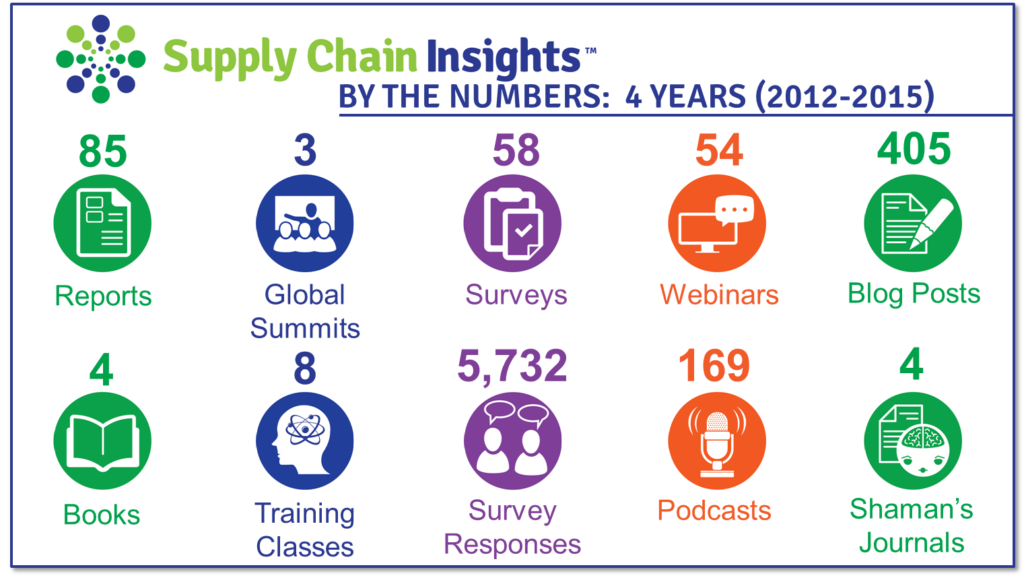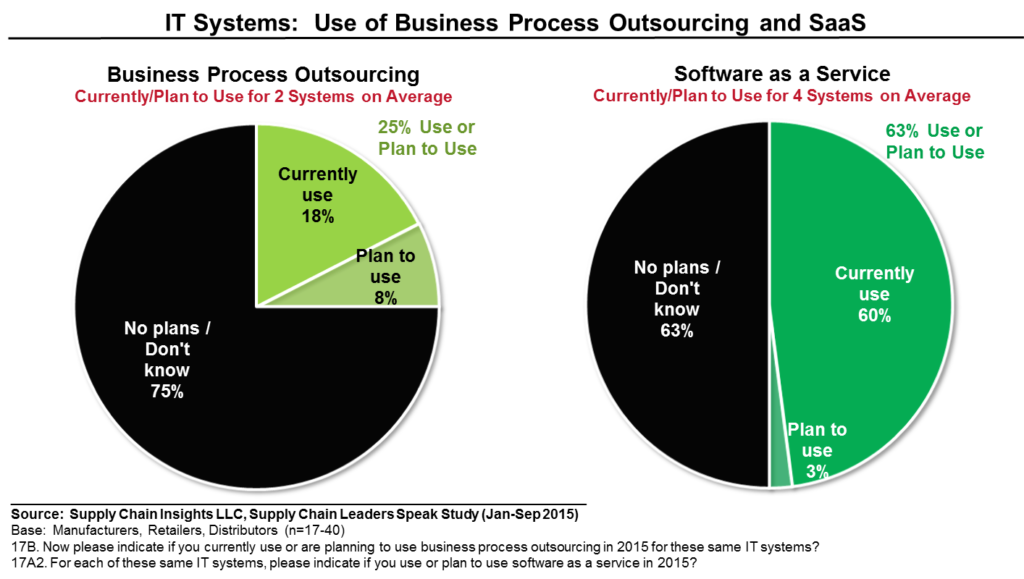 Six years ago, on a snowy January afternoon, I wrote my first post for the Supply Chain Shaman. It seems so long ago, but I still remember the fear I felt hitting the publish button for the first time.
Six years ago, on a snowy January afternoon, I wrote my first post for the Supply Chain Shaman. It seems so long ago, but I still remember the fear I felt hitting the publish button for the first time.
The blog was uglier then and less polished, and I have learned a lot about blogging over the years; however, my focus is the same. My goal is to write insights for the supply chain visionary.
The Supply Chain Shaman is an independent blog. I take independence seriously. You will note that there is no advertising for the blog and I am never paid to write. My take on the market is my own based on what I hear and see, and I tell it like it is. I am known as the old gal that is a straight shooter.
While my first posts were read by less than one hundred people, my current posts are read by over 15,000 people globally. I remain in amazement at the possibilities to create content and share it globally with a push of a button from your kitchen table.
This is my 310th post. I average a post a week. While I blog more business-focused research on Forbes, and tell stories from my travels on LinkedIn, this is my blog for the technology leader attempting to stay current on supply chain technology trends.
The source of the content is research. I manage a team at Supply Chain Insights and actively publish using an Open Content research model. Annually we invest 22% of revenues in building content. This Tuesday we will publish our 87th report, and our 167th podcast, in our 36th newsletter. We take content seriously. Each month we actively manage 2 to 4 quantitative surveys and we currently sit on over 5,500 responses. In the next couple of months we will be mining the cross-survey data for greater insights and sharing them with you in the form of infographics.
Figure 1. Overview of Supply Chain Insights

Last night, as I was working on the report for the newsletter, I wrote a summary of the last study which we completed in 2015 on the adoption of technology. I wanted to share some of the insights here.
The Evolution of Supply Chain Technology Adoption: Beginning of the Third Act?
Every supply chain organization is slightly different. One of the barriers to greater progress in driving supply chain excellence is the current state of user satisfaction with current technologies. The gaps are large. Companies are more satisfied with transactional (think Enterprise Resource Planning (ERP)) versus planning systems. We are also more advanced on transportation and warehouse planning than supply chain planning. As shown in Figure 2, demand, supply, and production planning are the largest gaps.
Figure 2. Current Importance and Performance of Current Technologies

With the evolution of Software as a Service (SAAS) and Business Process Outsourcing (BPO) technologies there are now more options. As shown in Figure 3, while the adoption of SAAS was 5% in 2004 it is currently the deployment preference for the Line of Business Leader. (2004 data references the work that I completed while an analyst at AMR Research.) BPO adoption is slower with more hiccups.
Figure 3. Adoption of Alternate Technology Deployments

While I once thought that Business Process Outsourcing in supply chain planning would be a promising market, I have changed my mind. Why? Two reasons drove this turnaround in my thinking.
- Shifts in Labor Rates. The relative labor rates of IT resources globally no longer make this a labor arbitrage play.
- Failure to Bring Strong Supply Chain Leaders to Market in Indian Services Firms. While the Indian firms have been, and continue to be, strong in data services they have not been able to bring teams with the process understanding to drive innovation in supply chain planning.
In 2016, 45% of companies plan to increase technology spending. The focus is on improving planning and execution. Line of Business power in decision making is increasing. 33% of Line of Business leaders are making the sole decision on technology and 50% of the decisions are made jointly. The purchase of supply chain solutions remains a complex sale with increased power by Line of Business Leaders. Business leaders want to know how can we make solutions easier to use, and more visual, while responding at the cadence of the business.
Figure 4. Focus of Spending Increases

In the market there is a clearer understanding that the software planning functionality by Oracle and SAP does not meet today’s business requirements. Oracle and SAP have not been able to bring enough domain expertise to solution development to stay current with the market requirements. As a result, more and more companies are starting to experiment with new forms of SaaS technologies. I believe we are starting to see the beginning of the The Third Act of supply chain planning technologies. The impact is unclear. There are several options:
- Will it improve the market for established vendors like Arkieva, Demand Solutions, JDA, John Galt, Logility, OM Partners, Ortec and Quintiq moving to hosted on-demand solutions?
- Or favor the adoption of SaaS solutions from Logfire, Kinaxis, ModelN, and Steelwedge? (Especially with the current rewrite of the code for greater scalability)
- Open the door for new solution approaches from firms like Anaplan, Enterra Solutions, o9, or Terra Technology?
- Begin a new chapter of supply chain analytics with FusionOps, Halo, Qlik, Trufa, and SAP HANA?
- Will non-relational solutions start to redefine digital supply chain initiatives? Is it time for Cloudera, Savi, and SAS to redefine what is possible?
- Or perhaps drive a new market for interoperability between and amongst B2B Operating Networks like GT Nexus, E2open, and Elemica?
The answer is unknown; but what is for sure, the market is going to be far more interesting in 2016. …a good place for the Supply Chain Shaman to pen another 50 posts.
What do you think? How do you see 2016? We look forward to your comments. For additional information on the Third Act check out these prior posts:
The Third Act
Preparing for the Third Act
Joining Forces for the Third Act
After you have time to think about it, come join the discussion at Beet Fusion or register for the upcoming Supply Chain Insights Global Summit. We guarantee it will not be boring.
About Lora:
 Lora Cecere is the Founder of Supply Chain Insights. She is trying to redefine the industry analyst model to make it friendlier and more useful for supply chain leaders. Lora has written the books Supply Chain Metrics That Matter and Bricks Matter, and is currently working on her third book, Leadership Matters. She also actively blogs on her Supply Chain Insights website, at the Supply Chain Shaman blog, and for Forbes. When not writing or running her company, Lora is training for a triathlon, taking classes for her DBA degree in research, knitting and quilting for her new granddaughter, and doing tendu (s) and Dégagé (s) to dome her feet for pointe work at the ballet barre. Lora thinks that we are never too old to learn or to push for excellence.
Lora Cecere is the Founder of Supply Chain Insights. She is trying to redefine the industry analyst model to make it friendlier and more useful for supply chain leaders. Lora has written the books Supply Chain Metrics That Matter and Bricks Matter, and is currently working on her third book, Leadership Matters. She also actively blogs on her Supply Chain Insights website, at the Supply Chain Shaman blog, and for Forbes. When not writing or running her company, Lora is training for a triathlon, taking classes for her DBA degree in research, knitting and quilting for her new granddaughter, and doing tendu (s) and Dégagé (s) to dome her feet for pointe work at the ballet barre. Lora thinks that we are never too old to learn or to push for excellence.







